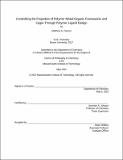Controlling the Properties of Polymer Metal-Organic Frameworks and Cages Through Polymer Ligand Design
Author(s)
Pearson, Matthew A.
DownloadThesis PDF (14.01Mb)
Advisor
Johnson, Jeremiah A.
Terms of use
Metadata
Show full item recordAbstract
Chapter 1: Synthetic and Design Considerations in Polymer Metal Organic Frameworks and Cages
Strategies for developing polymer-tethered MOF/MOC hybrid materials are discussed. Emphasis is place on the impacts of synthetic strategy and polymer ligand design on the properties and applications of the end material.
Chapter 2: PolyMOF Nanoparticles: Dual Roles of a Multivalent polyMOF Ligand in Size Control and Surface Functionalization
A simple strategy to access functional MOF nanoparticles in one pot is reported using a ligand possessing a polymer block for surface functionalization and a coordination block with tunable multivalency for size control. This strategy produces uniform polyMOF-5 and polyUiO66 nanoparticles with sizes down to 20 nm, displaying exceptional structural and colloidal stability.
Chapter 3: Radical PolyMOFs: A Role for Ligand Dispersity in Enabling Crystallinity
Reported here is the synthesis of polyMOF ligands featuring MOF-forming linkers on their sidechains using common radical polymerization techniques: reversible addition fragmentation chain transfer (RAFT) polymerization and free radical polymerization (FRP). High-dispersity ligands prepared through FRP formed crystalline polyMOFs while low-dispersity RAFT ligands required the addition of free H2bdc to yield crystalline materials analogous to MOF-5 and UiO-66, suggesting that ligand dispersity is a key design parameter for polyMOF synthesis.
Chapter 4: Mixed Ligands as a General Strategy for Tuning the Properties of polyMOFs and the Synthesis of MTV-polyMOFs
A strategy of mixing free linker with a step-growth polymer ligand containing MOFforming linkers is investigated as a means to tune modify the properties of polyMOFs, resulting in polyMOFs with superior N2 and CO2 uptake. The strategy is further studied by combining distinct MOF-forming polymer ligands to create MTV-polyMOFs, presenting a method for incorporating low-dispersity polymer ligands with complex architectures into polyMOF lattices without the addition of small molecule components.
Chapter 5: Polymer Metal Organic Cages from RAFT Polymerization
Here, a RAFT polymer ligand for the synthesis of Cu-paddlewheel, isophthalic acidbased bulk polyMOC powders is developed. The crystallinity and morphology of the polyMOCs can be tuned by addition of varying amounts of free isophthalic acid. These polymer/MOC hybrids represent a unique morphology and provide a platform for the synthesis of more complex hybrids.
Date issued
2022-05Department
Massachusetts Institute of Technology. Department of ChemistryPublisher
Massachusetts Institute of Technology